This is a book fans of the show "I Love Lucy," hereafter referred to as ILL, have been waiting for. (And how many zillions of fans are there?!) The book fleshes out the life of the actress best-known for her supporting role on television's groundbreaking, most beloved, and most durable, situation comedy. Sure, any real Lucy fan knew
something about Vivian Vance's stage experience, that she had been on Broadway before ILL. They might have even known she sang in New York supper clubs for a while before that and developed a pretty fair reputation as a torch singer.
But it's a sure bet most don't know that Vivian lied about her age and many other circumstances of her real life, hiding behind a mask of humor and sarcasm; that she had a contentious relationship with her mother--a repressed, fire-and-brimstone kind of gal--that colored her behavior; that she loved men, and needed sex, marrying four times, and occasionally propositioning costars; that she also branded herself a sinner and experienced much guilt over her success; and that her final (and happiest) marriage was to a gay man who reputedly gave up his previous life (and lover of 20 years) for love of Vivian.
The authors write with what can only be called a great deal of love and respect for their subject. The result is a full-bodied portrait of Vivian Vance, the woman, the person, and the artist, in which Lucille Ball and ILL are the supporting characters. It's a rare treat, and about time that Viv was given her due, considering that her influence on TV
comedy is felt to this day.
Born in 1909 (two years earlier than previously reported), Vivian grew up in Independence, Kansas, of English, Irish and Scottish heritage, the second of seven children born to Mae and Robert Jones. Apparently, almost from birth, she was dying to get out of Kansas; as she once put it, "Dorothy was so happy to wake up in Kansas. Not I! I'd have looked for another cyclone and stood right in its path!" She hated domestic life, had little use for school, yearned to get out and party, and by the time she graduated high school was striking enough (5'7", blond hair, blue eyes) to interest the producer of the touring Ziegfeld Follies. Her mother put the kibosh on that possibility, of course. In fact, her family's lack of support, and her mother's brackish personality, instilled in her a lack of achievement that followed her all her life. She felt separate and apart from her family, except for one younger sister, Dorothy, and though she adored her father, she didn't know how to please him, either. ItÕs no wonder that, blessed with a natural talent to perform, she got out of there as quickly as she could.
Her first professional job was performing in Tulsa, Okla. at the Crystal City amusement park; she was a vocalist in the big-band pavilion. Lonely and alone, she latched onto a guy who did publicity for a touring show, "Broadway," a melodramatic musical that had been a hit in New York. He procured her a place in the chorus; she married him (so her mother couldn't say they were living in sin), and Vivian Roberta Jones became Vivian Vance--she borrowed her new last name from a playwright she met before leaving Kansas. She was never really out of work after that.
She toured in a couple of shows as a chorus girl, got lonely and joined her family, which had moved to Albuquerque, N.M. after she'd left. Against Mama's wishes, she got a part in "Cushman's Revue", a vaudeville entertainment, singing torch songs, and becoming Albuquerque's fairest flower in the process. When the show toured, she went with it (no working at her dad's grocery for Vivian). By the time she'd had enough of small towns and traveling alone, Albuquerque was waiting for her with a vengeance: a former Broadway actress named Kathryn Kennedy O'Connor had formed the Albuquerque Little Theater, and invited Viv to perform with her company.
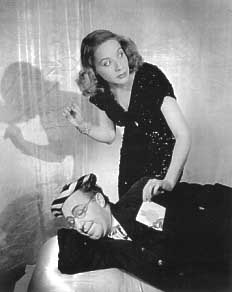 Through a series of successful performances in showcase parts, Vivian began getting major attention from reviewers in the area. Her success in Albuquerque was such that wags called the theater the Vivian Vance Playhouse. Eventually, O'Connor lobbied successfully for the proceeds of a Little Theater production to be used to send Vivian to New York, and arranged an audition for Viv with Eva Le Gallienne's prestigious Civic Repertory Theater. The audition was a moot point (Le Gallienne wasn't accepting anyone into her group that year); it got Viv to New York, where she eventually auditioned for the show "Hard to Get," which became "Anything Goes," starring Ethel Merman.
Through a series of successful performances in showcase parts, Vivian began getting major attention from reviewers in the area. Her success in Albuquerque was such that wags called the theater the Vivian Vance Playhouse. Eventually, O'Connor lobbied successfully for the proceeds of a Little Theater production to be used to send Vivian to New York, and arranged an audition for Viv with Eva Le Gallienne's prestigious Civic Repertory Theater. The audition was a moot point (Le Gallienne wasn't accepting anyone into her group that year); it got Viv to New York, where she eventually auditioned for the show "Hard to Get," which became "Anything Goes," starring Ethel Merman.
Vivian landed in the chorus and graduated to a speaking part when the book writers, Russell Crouse and Howard Lindsay, wrote a few lines for the chorus, and Viv delivered them with style. Her four lines turned into a small part, and she ended up understudying Merman (who was notorious for rarely missing a performance). But she did get to go on
several times as the lead, which must have been heady for the girl from Kansas.
Her subsequent theater experience--straight plays and musicals, Broadway (that's her starring in "Hooray for What! with Ed Wynn, circa 1937, above right) and touring companies, playing opposite the best and the worstÑprepared Viv for anything. She met her next husband, the actor Phil OberÑthere was a second husband before Ober, making him #3 --through her friend and benefactor Antoinette Perry (yes, the one the Tony Awards were named after). In fact, one of the things that most impresses about Vivian's life is how many successful and important people she knew, and how many of them admired her.
Ober, who came from a patrician New England background, and Vivian couldnÕt have been more opposite, and troubles surfaced immediately, but Viv suppressed them as she did many of her problems, and put on a happy gloss for the public. Eventually, after starring on Broadway again in "Let's Face It" (circa 1942-43) and going over to Europe and Africa to
tour for the soldiers (a horrid experience by all accounts), Viv began showing outward signs that something was not right. The culmination was a nervous breakdown, while performing in the show "The Voice of the Turtle." She went into analysis, didn't perform for a while, and by the late 1940s was slowly easing her way back onto the stage. She did several small movie roles out in Hollywood, and periodically escaped to her and PhilÕs ranch in Cubero, N.M.
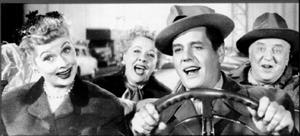 That's where she got the now fateful call from friend Mel Ferrer to play in "The Voice of the Turtle" at his theater in La Jolla, Calif. (the same part during which sheÕd had her breakdown; she was unwilling to go, but her husband and Ferrer convinced her to do it). She got excellent reviews (she always got excellent reviews) and of course, director Marc Daniels, whom Viv had known from her theater work, took Desi Arnaz to see her on a summer weekend in 1951. Daniels thought Viv would be perfect for the role of Ethel Mertz in their new sitcom. After seeing her, Desi agreed. Lucy took a little more convincing, but she eventually accepted Viv when she realized what an accomplished performer she was, and how committed Viv was to making the show a success. Those were qualities Lucy could admire (and rarely admitted to in any other performer).
That's where she got the now fateful call from friend Mel Ferrer to play in "The Voice of the Turtle" at his theater in La Jolla, Calif. (the same part during which sheÕd had her breakdown; she was unwilling to go, but her husband and Ferrer convinced her to do it). She got excellent reviews (she always got excellent reviews) and of course, director Marc Daniels, whom Viv had known from her theater work, took Desi Arnaz to see her on a summer weekend in 1951. Daniels thought Viv would be perfect for the role of Ethel Mertz in their new sitcom. After seeing her, Desi agreed. Lucy took a little more convincing, but she eventually accepted Viv when she realized what an accomplished performer she was, and how committed Viv was to making the show a success. Those were qualities Lucy could admire (and rarely admitted to in any other performer).
What we knew of Vivian's life up until now came mostly from this period, when she appeared in ILL, won an Emmy, began a lifelong mutual hatred of her onscreen husband, William Frawley, joined Lucy for her next series, "The Lucy Show," and so on. But this book fills in the gaps, the details about her unique relationship with literary ace John Dodds; her struggle to deal with how popular she had become as Ethel; several interesting might-have-been parts ( "Auntie Mame" with Roz Russell, and on Broadway in Woody Allen's "Don't drink the Water"); and her attempt to build a peaceful life out of the spotlight. She was mostly successful, and when she didnÕt work, it was because she didn't want to. She was sad that a movie career never developed after 1965's "The Great Race," but her public face was, as usual, funny and
succinct: "I had more costumes than lines," she quipped. If she needed an audience, she would go on tour or do summer stock. She was most proud of her work with the mentally ill, and whatever she could do to publicize depression as an illness, she did. That included talking to patients, something at which she excelled and enjoyed. She also was a mentor to many young performers, teaching them what she knew about comedy.
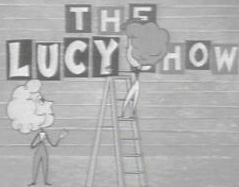 When she learned of Frawley's death in 1966, she toasted colleagues at Sardi's. Thereafter, whenever fans inquired about Fred Mertz's whereabouts, she told them he was dead. Vivian was nothing if not a straight-shooter. The cancer that took her life was slow in coming, and eventually she decided enough was enough, but not before one last get-together with the red-haired clown with whom she would always be associated. The book begins with this poignant moment.
When she learned of Frawley's death in 1966, she toasted colleagues at Sardi's. Thereafter, whenever fans inquired about Fred Mertz's whereabouts, she told them he was dead. Vivian was nothing if not a straight-shooter. The cancer that took her life was slow in coming, and eventually she decided enough was enough, but not before one last get-together with the red-haired clown with whom she would always be associated. The book begins with this poignant moment.
I laughed out loud more than once reading Viv's own words or hearing her quoted. She was a funny, warm, intelligent woman, definitely no saint, with a lot of insecurities, who gave joy to millions of people through her work onstage, TV, and off-stage. The authors have done right by Vivian, giving the reader a sense of a life well-lived, of a unique personality who, fortunately, will be with us forever in reruns. She might not have liked that idea, but personally, I couldn't be happier.

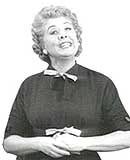
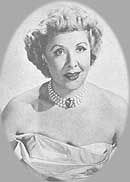

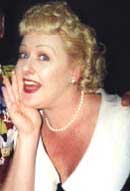
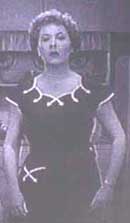
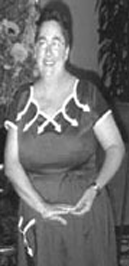
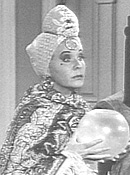
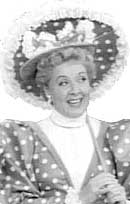
 by Frank Castelluccio and Alvin Walker
by Frank Castelluccio and Alvin Walker Through a series of successful performances in showcase parts, Vivian began getting major attention from reviewers in the area. Her success in Albuquerque was such that wags called the theater the Vivian Vance Playhouse. Eventually, O'Connor lobbied successfully for the proceeds of a Little Theater production to be used to send Vivian to New York, and arranged an audition for Viv with Eva Le Gallienne's prestigious Civic Repertory Theater. The audition was a moot point (Le Gallienne wasn't accepting anyone into her group that year); it got Viv to New York, where she eventually auditioned for the show "Hard to Get," which became "Anything Goes," starring Ethel Merman.
Through a series of successful performances in showcase parts, Vivian began getting major attention from reviewers in the area. Her success in Albuquerque was such that wags called the theater the Vivian Vance Playhouse. Eventually, O'Connor lobbied successfully for the proceeds of a Little Theater production to be used to send Vivian to New York, and arranged an audition for Viv with Eva Le Gallienne's prestigious Civic Repertory Theater. The audition was a moot point (Le Gallienne wasn't accepting anyone into her group that year); it got Viv to New York, where she eventually auditioned for the show "Hard to Get," which became "Anything Goes," starring Ethel Merman.  That's where she got the now fateful call from friend Mel Ferrer to play in "The Voice of the Turtle" at his theater in La Jolla, Calif. (the same part during which sheÕd had her breakdown; she was unwilling to go, but her husband and Ferrer convinced her to do it). She got excellent reviews (she always got excellent reviews) and of course, director Marc Daniels, whom Viv had known from her theater work, took Desi Arnaz to see her on a summer weekend in 1951. Daniels thought Viv would be perfect for the role of Ethel Mertz in their new sitcom. After seeing her, Desi agreed. Lucy took a little more convincing, but she eventually accepted Viv when she realized what an accomplished performer she was, and how committed Viv was to making the show a success. Those were qualities Lucy could admire (and rarely admitted to in any other performer).
That's where she got the now fateful call from friend Mel Ferrer to play in "The Voice of the Turtle" at his theater in La Jolla, Calif. (the same part during which sheÕd had her breakdown; she was unwilling to go, but her husband and Ferrer convinced her to do it). She got excellent reviews (she always got excellent reviews) and of course, director Marc Daniels, whom Viv had known from her theater work, took Desi Arnaz to see her on a summer weekend in 1951. Daniels thought Viv would be perfect for the role of Ethel Mertz in their new sitcom. After seeing her, Desi agreed. Lucy took a little more convincing, but she eventually accepted Viv when she realized what an accomplished performer she was, and how committed Viv was to making the show a success. Those were qualities Lucy could admire (and rarely admitted to in any other performer).  When she learned of Frawley's death in 1966, she toasted colleagues at Sardi's. Thereafter, whenever fans inquired about Fred Mertz's whereabouts, she told them he was dead. Vivian was nothing if not a straight-shooter. The cancer that took her life was slow in coming, and eventually she decided enough was enough, but not before one last get-together with the red-haired clown with whom she would always be associated. The book begins with this poignant moment.
When she learned of Frawley's death in 1966, she toasted colleagues at Sardi's. Thereafter, whenever fans inquired about Fred Mertz's whereabouts, she told them he was dead. Vivian was nothing if not a straight-shooter. The cancer that took her life was slow in coming, and eventually she decided enough was enough, but not before one last get-together with the red-haired clown with whom she would always be associated. The book begins with this poignant moment.